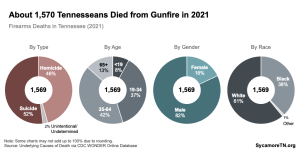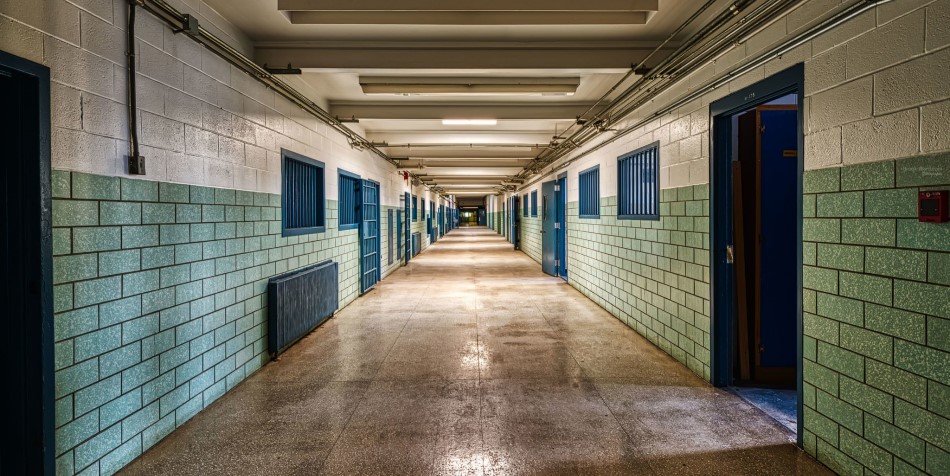
State and local leaders have implemented social distancing and “Safer at Home” policies to slow the spread of COVID-19, the disease caused by the new coronavirus. However, Tennessee’s local jails and state prisons may not have the space required to minimize risks of transmission between inmates, staff, and the community. This report explains why many Tennessee jail and prison populations face increased risks from COVID-19 and how that creates additional risks for the general public.
Key Takeaways
- The most recent available data show 60% of Tennessee’s local jails and state prisons were near, at, or over capacity at the end of February. Of 116 active jails, 46 had more inmates than beds.
- The close quarters of jails and prisons operating near, at, or over capacity make it harder to take steps public health experts recommend to slow the spread of COVID-19.
- Jails and prisons could potentially serve as reservoirs for future COVID-19 outbreaks among the general public due to the heightened infection risks for inmates, staff, and those around them.
- As TDOC and some county sheriffs take steps to combat COVID-19 in their facilities, state and local leaders may want to consider more ways to protect health while guarding public safety.
Figure 1
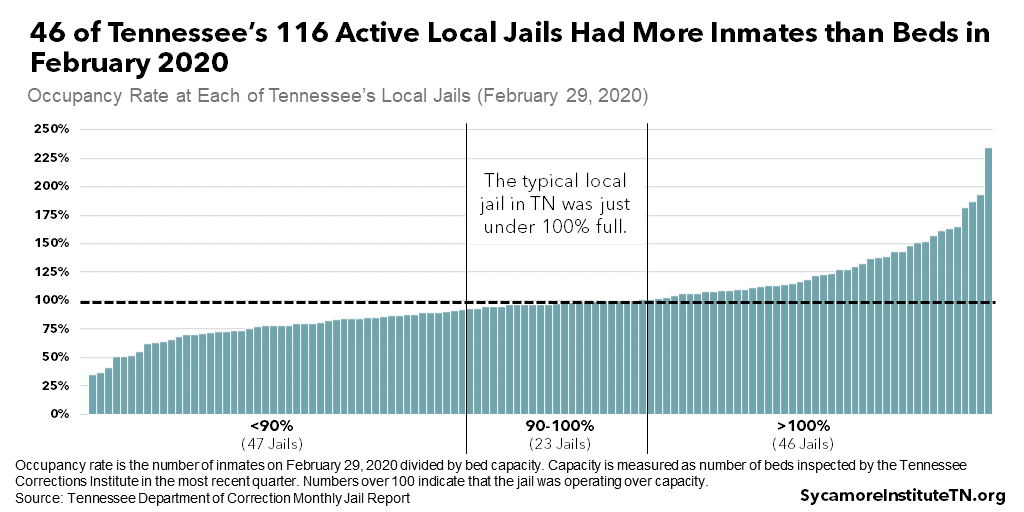
60% of Jails and Prisons Were Recently Close to or Over Capacity
The most recent available data show 60% of Tennessee’s local jails and state prisons were near, at, or over capacity at the end of February. (1) (2) This number represents a starting point for efforts to understand how crowding in our state’s correctional facilities might affect public health during the COVID-19 pandemic. While the total statewide jail population has reportedly dropped about 25% since mid-March, the details of that decline are not yet public. (3) Even so, some counties likely continue to operate jails near, at, or over capacity.
Capacity and Occupancy at Local Tennessee Jails
Forty-six of Tennessee’s 116 active local jails had more inmates than beds on February 29, 2020 (Figure 1). (1) These jails are located in 43 of Tennessee’s 95 counties — primarily in Middle and East Tennessee (Figure 2). Another 23 jails, each in separate counties, were operating at between 90-100%. Statewide, the typical jail was just under 100% capacity, with a low of 0% at the Pickett County jail to a high of 234% at a Cocke County facility.
Figure 2
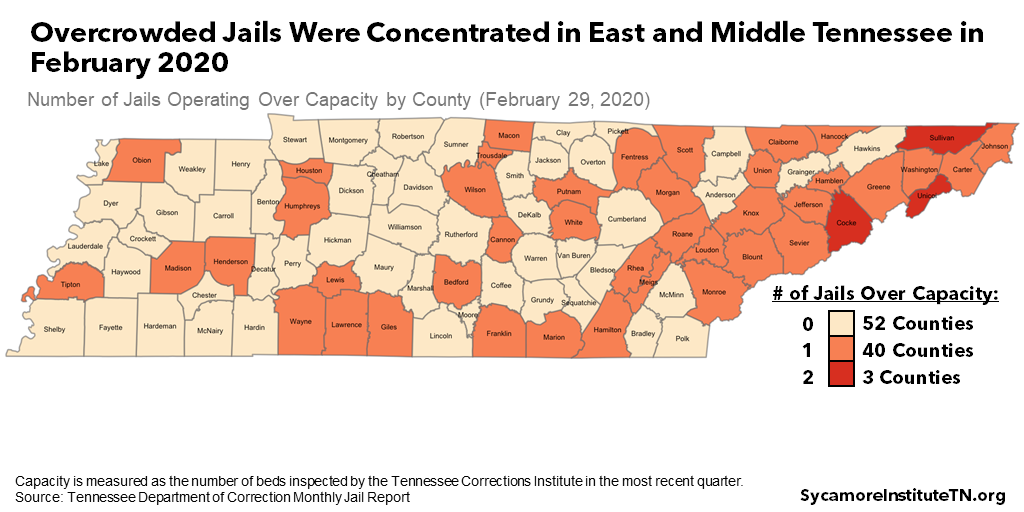
These numbers fell slightly from the prior month, when 54 jails were over capacity and the typical jail operated at 101% capacity. (4) Readers should interpret this shift with caution, however, as jail reports show one-day totals from the last day of each month rather than rolling averages.
On average, Tennessee counties operated their jails just under 102% of total bed capacity in February 2020.(1) Thirty-nine counties had more inmates across all facilities than they had beds, and another 22 were operating between 90-100% (Figure 3). Notably, nine counties were over 150% of capacity.
Figure 3
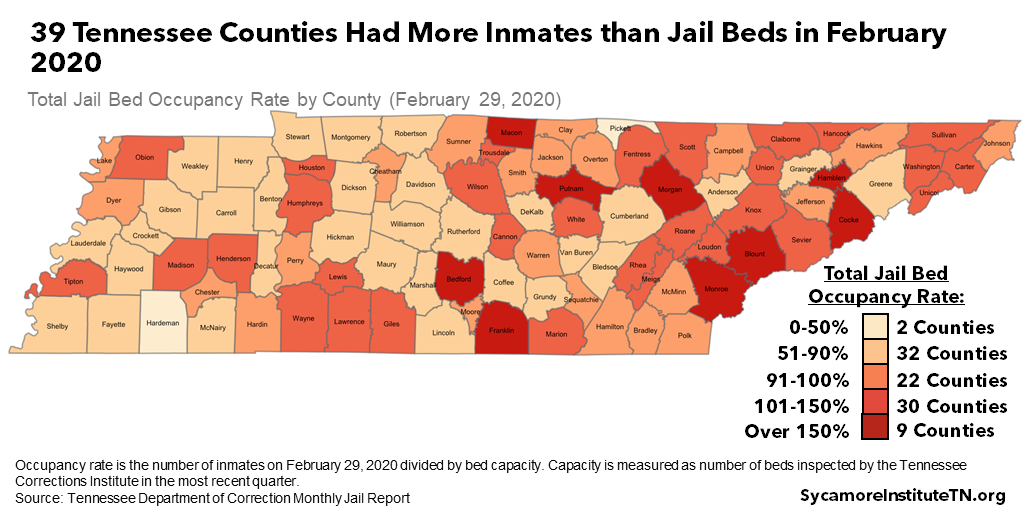
Tennessee’s local jails vary significantly in their bed capacity. Most counties in Tennessee have at least one hundred jail beds in their facilities (Figure 4). (1) Of the 73 counties with enough jail space to house at least 100 people, seven can house between 500 and 999 people, and five can hold over 1,000. Overall, the average county in Tennessee has the capacity to house about 350 people.
Figure 4
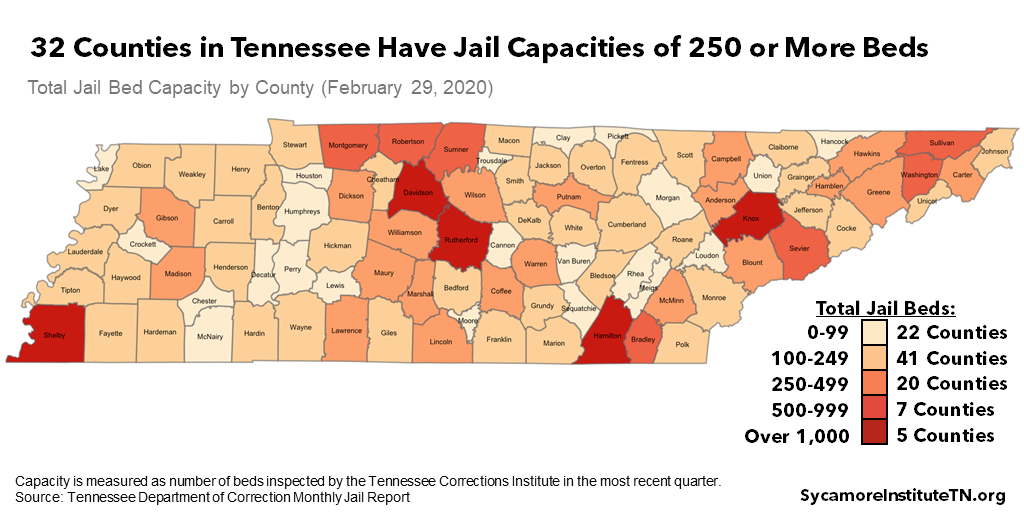
Just over 30% of jail inmates in the average county were state prisoners housed on behalf of the Tennessee Department of Correction (TDOC). (1) In Tennessee, jails house pretrial detainees, people serving misdemeanor sentences, and some felony offenders who fall under TDOC’s jurisdiction. The felony offenders can include those awaiting sentencing, inmates with shorter sentences, and others waiting for spots in a state prison. In 50 counties, convicted felony offenders made up between 25-50% of the total jail population on February 29, 2020 (Figure 5). In eight counties, state prisoners made up the majority of the jail population.
Figure 5
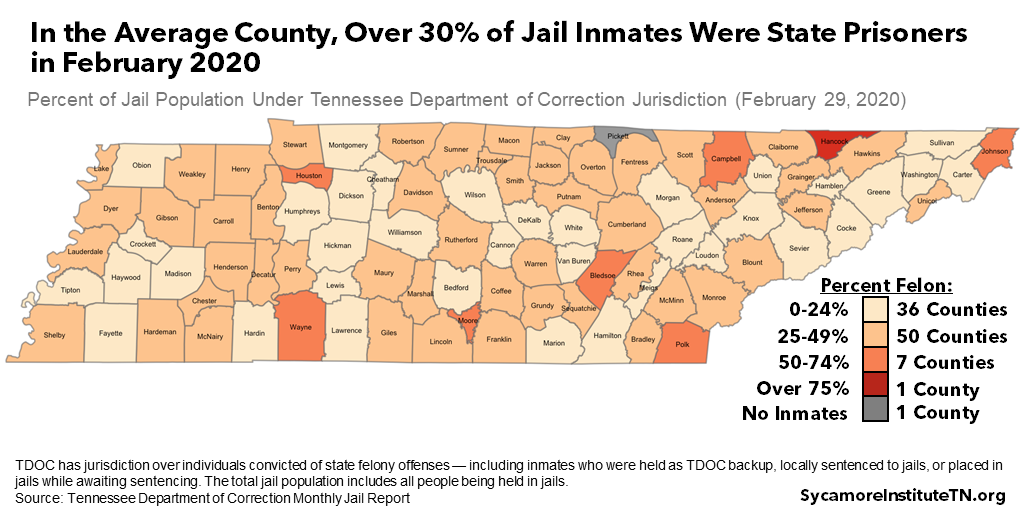
Capacity and Occupancy at Tennessee State Prisons
Two of Tennessee’s 14 state prisons operated at 100% capacity on March 31, 2020, and another seven were between 90-100%. (2) All four of Tennessee’s privately contracted or managed prisons were operating at 98% or higher (Figure 6). Overall, 12 Tennessee prisons saw a modest decline from the prior month in the number of inmates. (5)
Figure 6
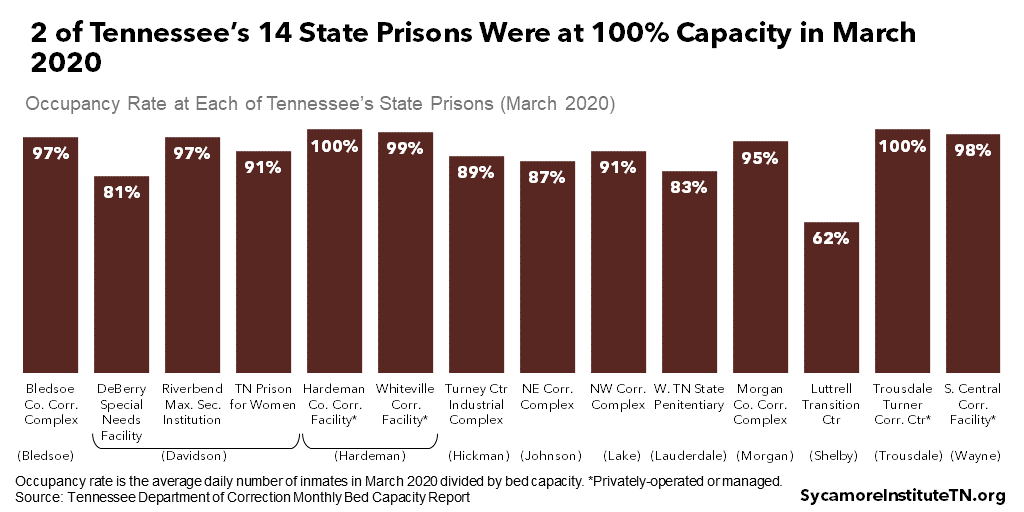
Crowding Makes It Hard to Slow the Spread of Infectious Disease
The close quarters of jails and prisons operating near, at, or over capacity make it harder to take steps public health experts recommend to slow the spread of COVID-19. For example, the U.S. Centers for Disease Control and Prevention (CDC) strongly advise Americans to increase good hygiene practices, avoid gatherings of more than 10 people, avoid eating in restaurant-type environments, work from home if possible, and reduce travel. (6) The way U.S. jails and prisons are designed can make policies like these very difficult to implement, even without overcrowding. (7) (8)
Many infectious diseases are much more common in jails and prisons than among the broader public. (9) (10) (11) While people entering incarceration are more likely to have certain conditions, life inside often promotes the rapid spread of infectious diseases. For example, Tennessee state prisons have recently experienced a rapid rise in Hepatitis C cases. (12) Policymakers made strides to control the situation by increasing funding for treatment last year, but cases and costs continue to rise. (13)
Jail populations, in particular, may be at a higher risk for catching and spreading COVID-19 as people typically churn in and out of jails daily. (14) (15) Nationwide, jail inmates were there an average of 25 days in 2018. (16) Not every Tennessee county publishes that information, but recent data for Davidson and Shelby County jails showed average stays of 24 and 31 days, respectively. (17) (18) Misdemeanor sentences can range from one day to just under a year, while the average felony sentence was just over 5 years for inmates housed at local jails in FY 2019. (19) For those in state prisons, the average sentence was 17.5 years.(20)
Outbreaks in Jails and Prisons Are Hazards for the General Public
Some experts believe jails and prisons could serve as reservoirs for future COVID-19 outbreaks among the general public. (21) (22) Health outcomes in correctional facilities are largely independent from those of the broader U.S. population due to statutory restrictions and limited coordination with public health efforts. (23) (24) If this virus circulates in correctional facilities even after the current pandemic subsides, it could reemerge to spark new waves of infection.
Over 1,300 confirmed cases of COVID-19 have been tied to correctional facilities across the United States. (25)(26) While several Tennessee facilities have reported cases, no major outbreak has been detected so far. (27) (28) (29) (30) However, TDOC had reportedly only tested 46 state prisoners as of April 13. (31) Outbreaks in Arkansas and New York suggest case numbers can rise quickly in jails and prisons — with infection rates potentially much higher than in the broader public. (32) (33) Likely with this in mind, TDOC on April 10 began mass testing employees at two facilities with confirmed cases of COVID-19. (34) Of the over 1,100 TDOC staff members who were initially tested, 19 came back positive. (35)
What Can Policymakers Do?
Many state and local leaders are looking for ways to protect the health of criminal justice populations and those around them while guarding public safety. In response, the National Sheriffs’ Association and the CDC have issued new guidance and informational resources to counties. (36) (37)
TDOC and some county sheriffs across the state have begun taking steps to combat COVID-19 in their facilities. State prisons have suspended visitation, waived medical co-pays, increased screenings for people entering the facilities, instituted new sanitation procedures in high touch areas, and made sure that soap is widely available. (38) Meanwhile, the Tennessee Supreme Court has asked judges to submit plans to reduce county jail populations and filed several orders to assist attorneys and others in the legal system during this pandemic. (39) (40)
Given the variation in facility size and occupancy across the state, counties will need to find the approaches that work best for their particular circumstances. The extent of action by officials in each county is not yet clear, but reports indicate wide variation. (41) (42) (43) (44) While the total statewide jail population has reportedly dropped about 25% since mid-March, some counties likely continue to operate jails near, at, or over capacity. (3) Examples of policies implemented by some Tennessee counties include:
- Early release for non-violent offenders near the end of their sentences.
- Expansion of existing pretrial release programs.
- Video visitation (some of which require fees).
- Suspension of church and educational services.
- Delaying new court proceedings for misdemeanors and other qualifying criminal charges.
- Quarantine contingencies in the event an inmate tests positive for COVID-19.
- Urging police to exercise discretion when choosing to make arrests or issue state citations.
Around the U.S., other steps that state and local governments have taken include: (45) (46) (47)
- Issuing statewide guidance and criteria for reducing jail populations.
- Waiving any required co-pays or charges for medical visits and hygienic materials.
- Using alternatives to money bond for people in jail while awaiting trial.
As long as there is no vaccine, policymakers will likely need to grapple with the challenges that COVID-19 poses for prisons and jails for the foreseeable future. Beyond reducing crowding, state and local officials may want to think about how the jail and prison population might remain lower than normal for an extended period.
Parting Words
The COVID-19 pandemic’s rapid spread has forced governments and public health officials at all levels to make tough policy choices with limited information. Many of these policies focus on good hygiene and social distancing, which can be harder to achieve in jails and prisons — especially crowded ones. With 60% of Tennessee’s prisons and jails recently near, at, or over capacity, state and local policymakers may want to consider how they can protect the health of our criminal justice populations and those around them while maintaining public safety.
References
Click to Open/Close
- Tennessee Department of Correction Decision Support: Research & Planning. Tennessee Jail Summary Report (February 2020). Tennessee Department of Correction. [Online] February 2020. https://www.tn.gov/content/dam/tn/correction/documents/JailFebruary2020.pdf.
- Tennessee Department of Correction. Tennessee Bed Space and Operating Capacities Report (March 2020). Tennessee Department of Correction. [Online] March 2020. https://www.tn.gov/content/dam/tn/correction/documents/BedMarch2020.pdf.
- Satterfield, Jamie. Poor and Jailed in Tennessee Face Uneven Justice Amid COVID-19 Pandemic, Review Shows. The Tennessean. [Online] April 12, 2020. https://www.tennessean.com/story/news/crime/2020/04/13/tennessee-disparities-coronavirus-jail-reduction/2974248001/.
- Tennessee Department of Correction Decision Support: Research & Planning. Tennessee Jail Summary Report (January 2020). Tennessee Department of Correction. [Online] January 2020. https://www.tn.gov/content/dam/tn/correction/documents/JailJanuary2020.pdf.
- —. Tennessee Bed Space and Operating Capacities Report (February 2020). Tennessee Department of Correction. [Online] February 2020. https://www.tn.gov/content/dam/tn/correction/documents/BedFebruary2020.pdf.
- The White House. The President’s Coronavirus Guidelines for America. U.S. Centers for Disease Control and Prevention. [Online] March 2020. https://www.whitehouse.gov/wp-content/uploads/2020/03/03.16.20_coronavirus-guidance_8.5x11_315PM.pdf.
- Kajstura, Aleks and Landon, Jenny. Since You Asked: Is Social Distancing Possible Behind Barrs? Prison Policy Initiative. [Online] April 3, 2020. https://www.prisonpolicy.org/blog/2020/04/03/density/.
- Williams, Brie, et al. Correctional Facilities In The Shadow Of COVID-19: Unique Challenges And Proposed Solutions. Health Affairs. [Online] March 26, 2020. https://www.healthaffairs.org/do/10.1377/hblog20200324.784502/full/.
- Bick, Joseph A. Infection Control in Jails and Prisons. Clinical Infectious Diseases. [Online] 45(8) 2007. https://www.ncbi.nlm.nih.gov/pubmed/17879924.
- Ndeffo-Mbah, Martial L., et al. Dynamic Models of Infectious Disease Transmission in Prisons and the General Population. Epidemiological Reviews. [Online] 40(1) 2018. https://www.ncbi.nlm.nih.gov/pmc/articles/PMC5982711/.
- Hammett, Theodore M. HIV/AIDS and Other Infectious Diseases Among Correctional Inmates: Transmission, Burden, and an Appropriate Response. American Journal of Public Health. [Online] 96(6) 2006. https://www.ncbi.nlm.nih.gov/pmc/articles/PMC1470637/.
- Timms, Mariah. Lack of Hepatitis Treatment Hurts ‘Chance of Redemption,’ Tennessee Inmate Testifies. The Tennessean. [Online] July 18, 2019. https://www.tennessean.com/story/news/2019/07/19/hepatitis-c-hcv-interferon-antivirals-treatment-tennessee-prison-department-of-corrections-court-cas/1760504001/.
- —. Judge Rules Against Inmates in Hepatitis C Lawsuit, Says State Policies Don’t Violate Rights. The Tennessean. [Online] October 1, 2019. https://www.tennessean.com/story/news/local/2019/10/01/hepatitis-c-hcv-tennessee-prisons-federal-court-ruling/3826018002/.
- Flagg, Anna and Neff, Joseph. Why Jails Are So Important in the Fight Against Coronavirus. The New York Times. [Online] March 31, 2020. https://www.nytimes.com/2020/03/31/upshot/coronavirus-jails-prisons.html.
- Harris, Mary. The Coronavirus Comes to Rikers Island. Slate. [Online] April 6, 2020. https://slate.com/technology/2020/04/coronavirus-covid19-rikers-island-jail-conditions-infections-freedom.html.
- Zheng, Zhen. Jail Inmates in 2018. U.S. Bureau of Justice Statistics. [Online] March 31, 2020. https://www.bjs.gov/content/pub/pdf/ji18.pdf.
- Davidson County Criminal Justice Planning. 2017 Annual Projection Report. Metro Government of Nashville & Davidson County, Tennessee. [Online] November 2017. https://www.nashville.gov/Portals/0/SiteContent/CriminalJusticePlanning/docs/Annual_Population_Projections_2017.pdf.
- Shelby County Sheriff’s Office: Jail Division. February 2019 Jail Report Card. Shelby County Sheriff’s Office. [Online] February 2019. http://www.shelbysheriff.org/resources/reports/jrc/JRC.pdf.
- Tennessee General Assembly. Tenn. Code Ann. § 40-35-111: Authorized Terms of Imprisonment and Fines for Felonies and Misdemeanors. [Online] https://advance.lexis.com/container?config=014CJAA5ZGVhZjA3NS02MmMzLTRlZWQtOGJjNC00YzQ1MmZlNzc2YWYKAFBvZENhdGFsb2e9zYpNUjTRaIWVfyrur9ud&crid=ba14dd14-e245-40b0-a3e1-241945f90964&prid=afa17570-f277-48ee-830d-029819e4e6f4.
- Tennessee Department of Correction Decision Support: Research & Planning. The Tennessee Department of Correction Fiscal Year 2019 Statistical Abstract. Tennessee Department of Correction. [Online] October 2019. https://www.tn.gov/content/dam/tn/correction/documents/StatisticalAbstract2019.pdf.
- Kaste, Martin. Prisons And Jails Worry About Becoming Coronavirus ‘Incubators’. National Public Radio. [Online] March 2020. https://www.npr.org/2020/03/13/815002735/prisons-and-jails-worry-about-becoming-coronavirus-incubators.
- Akiyama, Matthew J., Spaulding, Anne C. and Rich, Josiah D. Flattening the Curve for Incarcerated Populations — Covid-19 in Jails and Prisons. The New England Journal of Medicine. [Online] April 2, 2020. https://www.nejm.org/doi/full/10.1056/NEJMp2005687.
- Eisen, Lauren-Brooke. How Coronavirus Could Affect U.S. Jails and Prisons. The Brennan Center. [Online] March 2020. https://www.brennancenter.org/our-work/analysis-opinion/how-coronavirus-could-affect-us-jails-and-prisons.
- Fiscella, Kevin, Beletsky, Leo and Wakeman, Sarah E. The Inmate Exception and Reform of Correctional Health Care. American Journal of Public Health. [Online] 107(3) 2017. https://www.ncbi.nlm.nih.gov/pmc/articles/PMC5296706/.
- Williams, Timothy and Ivory, Danielle. Chicago’s Jail Is Top U.S. Hot Spot as Virus Spreads Behind Bars. The New York Times. [Online] April 8, 2020. https://www.nytimes.com/2020/04/08/us/coronavirus-cook-county-jail-chicago.html.
- Williams, Timothy, Weiser, Benjamin and Rashbaum, Williams K. Prisoners ‘Terrified’ as Coronavirus Spreads Behind Bars. The New York Times. [Online] March 2020. https://www.nytimes.com/2020/03/30/us/coronavirus-prisons-jails.html.
- Tamburin, Adam. First Tennessee State Prison Inmate Tests Positive for COVID-19. The Tennessean. [Online] April 4, 2020. https://www.tennessean.com/story/news/health/2020/04/04/coronavirus-tennessee-prison-inmate-tests-positive-covid-19/2947688001/.
- Alund, Natalie Neysa and Timms, Mariah. Davidson County Sheriff’s Office Jail Inmate Tests Positive for COVID-19. The Tennessean. [Online] April 6, 2020. https://www.tennessean.com/story/news/health/2020/04/06/nashville-jail-inmate-test-positive-covid-19/2955994001/.
- WMC Action News 5 Staff. 14 SCSO Employees, 1 Jail Detainee Test Positive for COVID-19. WMC Action News 5. [Online] April 6, 2020. https://www.wmcactionnews5.com/2020/04/06/scso-detainee-tests-positive-coronavirus/.
- Tennessean Staff. Wednesday April 1 Updates: Davidson County Sheriff’s Office Employee Tests Positive, TDOC Says 3 Inmates Likely Exposed. The Tennessean. [Online] April 1, 2020. https://www.tennessean.com/story/news/local/2020/04/01/coronavirus-news-tennessee-latest-updates-covid-19/5101200002/.
- Tamburin, Adam. Gov. Bill Lee Called for Widespread COVID-19 Testing, but TDOC has Tested Only 46 Inmates. The Tennessean. [Online] April 14, 2020. https://www.tennessean.com/story/news/2020/04/14/tennessee-prisons-have-only-tested-46-state-inmates-coronavirus/2984599001/.
- Cushman, Paige. ‘It’s Like Mad Max in Here’: Arkansas Inmate Says Conditions Woeful Amid Outbreak. WATV ABC Channel 7. [Online] April 15, 2020.https:/katv.com/news/local/its-like-mad-max-in-here-inmates-at-arkansas-prison-panic-amid-outbreak.
- The Legal Aid Society. COVID-19 Infection Tracking in NYC Jails. The Legal Aid Society. [Online] April 8, 2020. https://legalaidnyc.org/covid-19-infection-tracking-in-nyc-jails/.
- Timms, Mariah and Alund, Natalie Neysa. April 10 Coronavirus Updates: Tennessee COVID-19 Cases Rise to 4,634 on Thursday. The Tennessean. [Online] April 10, 2020. https://www.tennessean.com/story/news/local/2020/04/10/coronavirus-tennessee-updates-covid-19-cases/5125728002/.
- Alund, Natalie Neysa. TDOC: 13 Staffers, 6 Contract Employees Test Positive at Two Tennessee Prisons. The Tennessean. [Online] April 12, 2020. https://www.tennessean.com/story/news/2020/04/12/tennessee-prisons-inmates-positive-coronavirus-tests/2980441001/.
- National Sheriffs’ Association. Coronavirus (COVID-19) Information. National Sheriffs’ Association. [Online] April 2020. https://www.sheriffs.org/coronavirus.
- Centers for Disease Control and Prevention. Interim Guidance on Management of Coronavirus Disease 2019 (COVID-19) in Correctional and Detention Facilities. Centers for Disease Control and Prevention. [Online] April 2020. https://www.cdc.gov/coronavirus/2019-ncov/community/correction-detention/guidance-correctional-detention.html.
- Tennessee Department of Correction. Frequently Asked Questions Regarding COVID-19. Tennessee Department of Correction. [Online] March 2020. https://www.tn.gov/correction/frequently-asked-questions-regarding-covid-19.html.
- Tennessee Supreme Court. Tennessee Courts Remain Open, Limitations on In-Person Court Proceedings Extended Through April 30. Tennessee State Courts. [Online] March 25, 2020. https://tncourts.gov/press/2020/03/25/tennessee-courts-remain-open-limitations-person-court-proceedings-extended-through.
- —. Tennessee Supreme Court Takes Steps to Assist Attorneys, Legay System During COVID-19 Crisis. Tennessee State Courts. [Online] March 27, 2020. https://www.tncourts.gov/press/2020/03/27/tennessee-supreme-court-takes-steps-assist-attorneys-legal-system-during-covid-19.
- Stephenson, Cassandra. West Tennessee Sheriffs on What They’re Doing to Prepare for Coronavirus at County Jails. Jackson Sun. [Online] March 2020. https://www.jacksonsun.com/story/news/local/2020/03/18/west-tennessee-sheriffs-coronavirus-precautions-jails/5068754002/.
- Davidson County Sheriff’s Office. Sheriff Daron Hall Working To Reduce Jail Population During COVID-19 National Public Health Emergency. Davidson County Sheriff’s Office. [Online] March 2020. https://sheriff.nashville.gov/sheriff-daron-hall-working-to-reduce-jail-population-during-covid-19-national-public-health-emergency/.
- Cross, Josh. Sumner DA: 37 Inmates Released Early Amid County COVID-19 Outbreak. Hendersonville Standard. [Online] March 27, 2020. https://www.hendersonvillestandard.com/news/sumner-da-inmates-released-early-amid-county-covid–outbreak/article_88590668-7071-11ea-be6f-1776bd9ea176.html.
- Metropolitan Nashville Police Department. Officers Encouraged to Use Maximum Discretion in the Issuance of Misdemeanor Citations. Metro Government of Nashville & Davidson County, Tennessee. [Online] March 2020. https://www.nashville.gov/News-Media/News-Article/ID/9521/Officers-Encouraged-to-Use-Maximum-Discretion-in-the-Issuance-of-Misdemeanor-Citations.aspx.
- Jenkins, Jimmy. Prisons And Jails Change Policies To Address Coronavirus Threat Behind Bars. National Public Radio. [Online] March 2020. https://www.npr.org/2020/03/23/818581064/prisons-and-jails-change-policies-to-address-coronavirus-threat-behind-bars.
- The Marshall Project. Coronavirus Tracker: How Justice Systems Are Responding in Each State. The Marshall Project. [Online] March 2020. https://www.themarshallproject.org/2020/03/17/tracking-prisons-response-to-coronavirus.
- Tully, Tracey. 1,000 Inmates Will Be Released From N.J. Jails to Curb Coronavirus Risk. The New York Times. [Online] March 2020. https://www.nytimes.com/2020/03/23/nyregion/coronavirus-nj-inmates-release.html.
Featured image by Brook Ward




